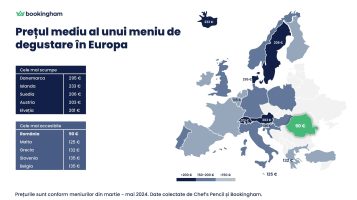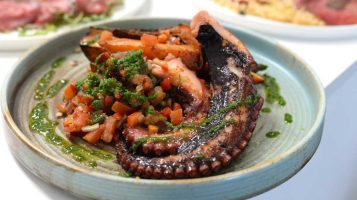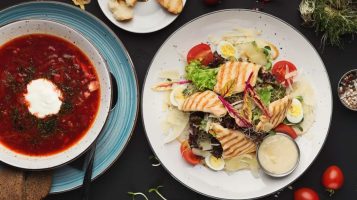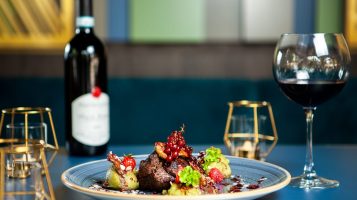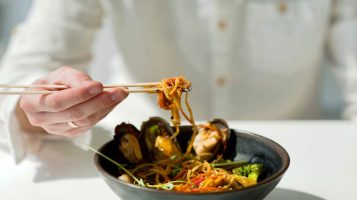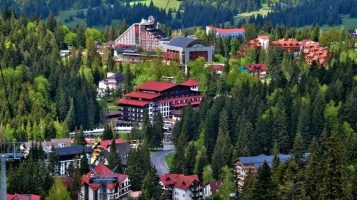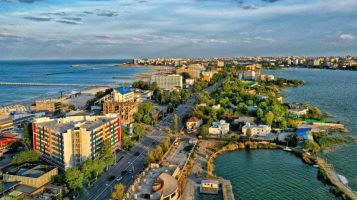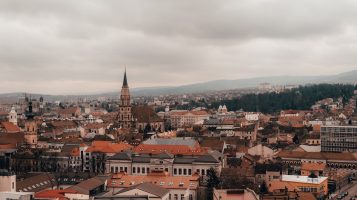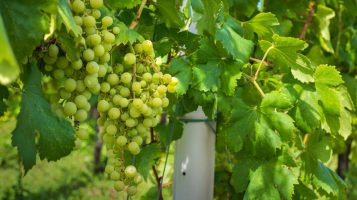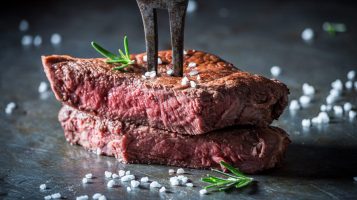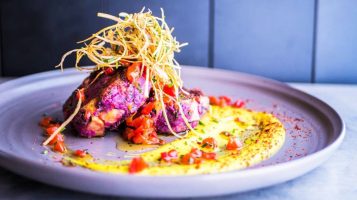If you’re on your way to, or just arrived, for an Eastern European foray and want to get excited about a combination of regional flair in both architecture, sights and cuisine, then Romania needs to be pretty high on your list. The country has carved itself a niche for a more focused brand of tourism that lends itself to those who want to explore its wild nature, its welcoming villages, and its rapidly developing cities.
Join us through a quick rundown of some of the top Romanian foods to enjoy while you’re over here, as we explore what makes them noteworthy and where you can find them.
From the bustle of Bucharest to the sleepy Danube Delta, there are plenty of spots that feature incredible diversity in culture, architecture and cuisine. Below, we’ve arranged a few of the top Romanian regional foods, what to expect from them, and where they can be found.
1. Ciorbă de Burtă (Tripe Soup) | Bucharest
We’re starting with Bucharest, the capital of Romania and by far its most populous city. This is the administrative, financial and cultural nerve center of the country, and one of the most diverse and fascinating cities in Europe. Bolstered by a rich history featuring mixes of Western European and Eastern, even Byzantine architectural features, this city features attractions like the world’s second-largest public building, The Palace of the Parliament, a building directly representing the country socialist modernism phase under communism. Look for places like Lipscani, a former mercantile area that’s now infused with cool coffee shops and dining spots.
A national staple, ciorba de burtă is frequently translated as tripe soup, but we feel that that might be a little reductive. Originated by the need to create hearty dishes from all available parts of the animal in the age of Medieval Wallachia, this soup is made by cooking the stomach lining of the animal (most commonly cattle) and is heavily flavored by using garlic, herbs, and lemon or vinegar, for a rich consistency with an acidic finish.
It is often garnished with hot green or red peppers and sour cream and features a wealth of helpful probiotics, as a great vessel for gut-friendly foods. Early variations of this dish have been documented as early as the 14th century south of the Carpathian mountains. A good spot to enjoy a bowl of this dish is Caru’ cu Bere, a traditional-style spot in the heart of Bucharest.
Learn more about the best restaurants in Bucharest and book a table to one of the myriad dining spots with Bookingham.
2. Papanași (Cheese-filled doughnuts) | Bucovina
Bucovina is one of the most spiritually rich regions in Romania – just ask its residents about it. Its green high plains, its incredible density of centuries-old churches, its penchant for producing legendary chieftains that are still talked about today, all weave into the grand tapestry that is Bucovina. Drive around and visit the Putna and Voroneț monasteries, as well as the fortress of Suceava for a history-filled move-around in northeast Romania.
We’re throwing you a dessert curveball early in the game, with papanași, a pure comfort food item that takes an Austro-Hungarian dish consisting of boiled sweet dough and throws in deep frying to kick things up a notch. Served with rich cow’s milk cheese from the rolling hills of Bucovina, this crispy creamy dessert will have you craving it again and again.
Not convinced? Oh, so a leavened, cheese-filled dough ball is deep fried then cooled off in a mix of sugar and sour cream, then topped off with spoonfuls of fruity jam—see, there’s fruit in it, this basically counts for your five-a-day!
Enjoyed in Bucovina, where the dough is fluffy, the cheese is fresh and fruit jams are plentiful, we’d recommend the fare at Apropo Cafe in Suceava. Book a table with them or discover other restaurants in Suceava on Bookingham.
3. Pleșcaviță (Serbian Patty) | Banat
One of the fastest-growing regions of Romania and traditionally a center for innovation within the country, Banat features an interesting mix of strong agricultural production, highly industrialized low mountains, and a cultural heritage characterized by its melding of Romanian, Serbian, Austrian, and Hungarian cultures. Its economic and cultural driver is Timișoara, the first European city to feature an electric street-lighting system.
A staple of Western Romania, pleșcaviță is a dish originated by Serbian cuisine, one that styles itself as a more legacy-style contender for the odd shawarma or burger offerings. This street food item is at its best when the beef-pork mix is made using baking powder, to give the resulting patty a specific bounciness, one that is then complimented by flavorful sauces, often including a vegetable preserve consisting of tomatoes, peppers and onions.
If you feel like sampling the student lifestyle in the city of Timișoara, then a cold bottle of Timișoreana beer and a pleșcaviță at Restaurant Nora is an experience you need to give a try. Do it while walking near the Bega’s riviera, just in time to see locals taking their kayaks for an evening spin.
Not sure where to start your culinary experience in the Banat region? Take your pick of the best restaurants in Timișoara on Bookingham, and make a reservation now.
4. Saramură de Știucă (Salted Pike) | Danube Delta
The Danube Delta is a major attraction for a number of reasons, chief among them being its unmatched biodiversity. There’s no other place in Europe that houses nearly as many species of birds and fish, and on a good day on its myriad small natural channels, you can get a glimpse of its wild horse colonies through the reeds. Look for its small settlements where welcoming fishermen will house and feed you, with boat trips through the aforementioned channels being the only reliable way to get around the area. Stop by a wild beach while you’re there and get a natural tan, just don’t forget to bring SPF.
The dish to have here is salted, grilled fish, that’s then thrown into an herby, green soup often using water directly from the Danube as the main condiment. This item is called saramură and it’s packed full of flavor. One of the staples is to have this dish made using one of the delta’s most widely available fish: pike. This fish can be caught even outside regular fishing seasons so it’ll likely be available anytime you choose to visit.
A trip to the Danube Delta should include Tulcea, the largest city in the region and the starting point for most of the wilder forays into the biosphere. Look for the salted pike at Ivan Pescar, but make time to explore all the top restaurants in Tulcea, the delta’s main urban center.
5. Varză à la Cluj (Cluj-Style Cabbage) | Transylvania
Shielded by the Carpathian Mountains on three sides and infused with Habsburgic culture due to its time as part of the Austro-Hungarian Empire, Transilvania is riddled with fortified churches, old Dacian fortresses and rolling green hills. This area owes a lot to its role in trading with Western Europe, and a distinct architectural character is what you’ll find in most of its major cities, clear standouts are Oradea and Sibiu.
The signature dish we’re picking for this region is one whose name pretty much gives away the plot, so even if we’d wanted to withhold the location of this next dish, we’d have had a pretty tall task ahead. Varză à la Cluj, or Cluj-style cabbage for the francophones out there, is an unassuming dish that wears its Austro-Hungaro-Romanian influences on its sleeve, in the heart of Transylvania.
Essentially a reimagined, almost casserole-style dish that reminds the palette of deconstructed stuffed cabbage, this spicy offering consists of spoonfuls of flavorful brined cabbage and a mix of minced meat, rendered with some pork fat and aromatics. Look for spots that offer these savory squares with a little oven char at the bottom. Don’t let anyone tell you any different, the only way to enjoy this dish properly is with a dollop of good quality sour cream and local bread, provided that you’ve earned your carbs for the day. We’d recommend the fare at Zama, a spot that fuses bistro-style aesthetics with the language and regional flair that true locals would use for these dishes.
Not sure where to start your gastronomic journey in Romania’s fastest-growing city? Bookingham can help you discover the right spot and book your first meal in just a few seconds, so check out the best restaurants in Cluj-Napoca now.
6. Plăcinte cu lobodă (Orache Pie) | Maramureș
No region on our list is happier to be exactly where it is than Maramureș. This place has more songs about being from here than most people have hairs on their head. And proud they should be. Located in the northern end of Romania, Maramureș features beautiful natural valleys, mountains that bloom every spring with wild daffodils and rhododendrons. Its villages have a penchant of turning their cultural heritage into agrotourism, and you won’t be able to resist their welcoming mix of moonshine and bacon.
Rounding out our list of regional culinary staples from Romania’s historic regions, we have northern Romania’s answer to pies, but with a Maramureș kick. These doughy platters offer a hearty mix of fresh cow-milk cheese with orache, a leafy wild alternative to spinach, and are called plăcinte cu lobodă, a local staple.
A well-known batter of flour, milk and eggs is the basis for this item, one that keeps everything fairly generic and well-known in the mixing and baking process. It’s when we get to the finishing touch that this dish transcends the barrier between savory snack and decadent delight. The fresh cow-milk cheese—which cannot be subbed out with ricotta!—is usually mixed with herbs and orache, then generously stuffed into these doughy receptacles. Some variations also use wild garlic in the cheese mix, for a true delight. Bastion’s take on these tasty treats is one we’d recommend, as long as you also try some of the local moonshine on the side.
Look for this dish, and other local delicacies, at the best restaurants in Baia Mare. This is a large mining town with a rich cultural background that’s turning its former industrial legacy into the place to be in northern Romania.
Honorable mentions
Although Romanian cuisine is slowly pivoting to a more international-themed selection where pasta dishes and pizza selections are more common than homemade staples like mămăligă or sarmale, there are plenty of menu items that still very much carry through the Eastern European country’s rich and very diverse gastronomic background.
Local shepherds across the country mix hot polenta with freshly made cheese and milk to come with the very succinctly-named bulz. This dish is at its most authentic when you’re further away from any civilization and its rich texture and hot serving temperature will help with the effort you’ve made to receive a bowl of this specialty.
If you’re into barbecuing but don’t want to wait 6 hours to make your dish, then mici are the thing to try. Essentially only referred to in the plural form because one just won’t be enough, this specialty is a minced-meat mix resembling uncased sausage that’s made fresh and thrown on a piping hot grill then charred on all sides. A slice of white bread, seasonal veggie salad and your favorite style of mustard to accompany and you’ll be mirroring the experience most Romanians crave every weekend. And we do mean every weekend.
Romania also has an emerging wine scene, one that features a growing number of high quality wineries that offer weekend packages filled with curated tastings, culinary experiences and boutique hospitality. Check out the regions of Vrancea, Banat and Dobrogea for some of the oldest and most popular wineries in the country.




